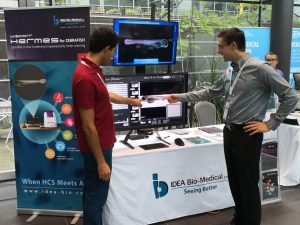Here we explore the groundbreaking research conducted by the Yaniv lab from the Weizmann Institute of Science in Israel, which leverages IDEA Bio-Medical’s advanced imaging tools, specifically the WiScan® Hermes microscope and the WiSoft® Athena software, to accelerate drug discovery for Kaposiform Lymphangiomatosis (KLA). Using a high-throughput zebrafish model, the team identified potential treatments for KLA, showcasing how Hermes and Athena enable precise analysis and effective screening of therapeutic compounds.

“The most important thing for this screen was to have a rapid outcome, something that we can use to verify that our samples are rescued or hit.
So, thanks to IDEA Bio-Medical, we came up with the idea to use the surface of the fish as a proxy to detect rescued samples because it was very clear.
And doing that, we identified 2 unexpected hits.”
Prof. Karina Yaniv, The Weizmann Institute of science
What is Kaposiform Lymphangiomatosis (KLA)?
KLA is an aggressive, rare lymphatic anomaly linked to the NRAS mutation (p.Q61R) in lymphatic endothelial cells (LECs). Current treatment options, including MEK inhibitors and mTOR inhibitors, have shown limited efficacy, highlighting an urgent need for novel therapeutic options. The lack of animal models that accurately replicate KLA has further hindered drug development.
Methods: Zebrafish Model and Imaging Tools
The Yaniv group developed a zebrafish model that conditionally expresses the NRAS mutation to simulate KLA symptoms, such as pericardial edema and dilated thoracic ducts. The zebrafish model provided a cost-effective, high-throughput platform for screening drugs, an approach made viable by the automated imaging capabilities of Hermes and the AI-driven analysis power of Athena.
- Hermes Imaging System:
- Automated Imaging: The Hermes system captured high-resolution images of zebrafish larvae, allowing rapid screening and visualization of complex phenotypes such as pericardial edema and vascular abnormalities.
- High Content Screening: By capturing entire zebrafish larvae at a cellular level, Hermes provided comprehensive data critical for analyzing drug efficacy.
- Athena Analysis Software:
- Deep Learning for Phenotype Recognition: The Athena software utilized AI-based segmentation to distinguish mutant phenotypes from wild-type characteristics, accurately quantifying total larva area and thoracic duct morphology.
- Customization for Precision: The research team refined Athena’s model by manually adjusting masks and anatomical markers, enhancing the AI’s sensitivity to KLA phenotypes.
Results: Identification of Novel Drug Candidates
The zebrafish model, in conjunction with the Hermes and Athena platforms, facilitated a high-throughput drug screening of 126 compounds, from which Cabozantinib and GSK690693 emerged as lead candidates. Key findings include:
- Drug Efficacy in Zebrafish: The AI identified compounds that reduced the mutant larvae’s swollen phenotype to wild-type levels. Cabozantinib, a tyrosine kinase inhibitor, and GSK690693, a pan-Akt inhibitor, both reverted the enlarged thoracic duct phenotype, suggesting their potential as KLA treatments.
- Validation in Patient-Derived Cells: Follow-up tests in LEC cultures derived from KLA patients confirmed the effectiveness of these compounds, underscoring their clinical potential.
Impact
The high-throughput capabilities of Hermes and Athena enabled the efficient, large-scale analysis necessary to identify effective treatments for KLA. Key contributions include:
- Accelerated Screening: The Hermes system’s automated image acquisition dramatically reduced the time required for each screening cycle.
- Enhanced Data Precision: Athena’s segmentation and quantification algorithms provided consistent, reproducible data, enhancing the statistical power of each drug’s efficacy evaluation.
In a Nutshell
This study highlights the power of IDEA Bio-Medical’s imaging and analysis tools to drive significant advancements in drug discovery for rare diseases like KLA. By enabling high-throughput, precise screening in complex models, Hermes and Athena represent a transformative leap in cell biology research, capable of expediting the path from discovery to treatment.

References:
- Bassi, I., Jabali, A., Farag, N., Egozi, S., Moshe, N., Leichner, G.S., Geva, P., Levin, L., Barzilai, A., Avivi, C. and Long, J., 2024. A high-throughput zebrafish screen identifies novel candidate treatments for Kaposiform Lymphangiomatosis (KLA). bioRxiv, pp.2024-03. https://doi.org/10.1101/2024.03.21.586124

What’s next for Zebrafish microscopy in 2023
News: What’s next for Zebrafish microscopy in 2023? Dr. Jason Otterstrom talks about the benefits and challenges of using Zebrafish as an emerging model for

Athena Zfish software- Installer
Time to Elevate Your Research with Athena Zebrafish Software! Dashboard | Technical overview | Pricing Our new, first-of-its-kind analysis software for automated analysis of Zebrafish microscopy images offers simple

Zebrafish: A Preclinical Model for Drug Screening
Zebrafish: A Preclinical Model for Drug Screening Download Software Preclinical models play a fundamental role in the drug discovery pipeline, enabling researchers to identify compounds

What is High Content Imaging?
What is High Content Imaging? High content imaging (HCI), is a powerful image-based paradigm used across the full spectrum of biochemistry, cellular biology, microbiology, molecular
